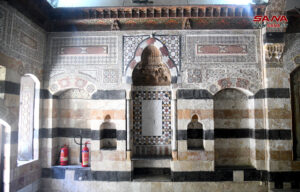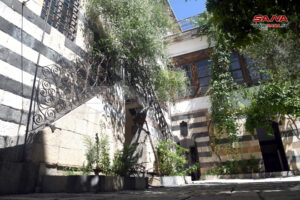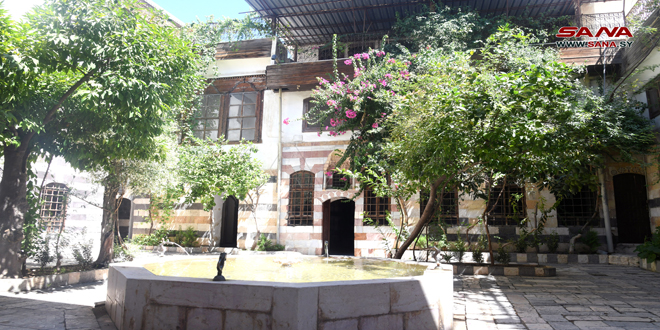Beit Al-Sibai (House of Al-Sibai) is one of the original Damascene houses in terms of the architectural construction style and the elements used in its construction.
This house, which is located in Al Daqaqin Quarter near Al-Buzuriyeh Market, was completed in 1187 Hijri, according to architect Beshr El Barri, the architect of the site at the Aga Khan Foundation for Cultural Services. It consists of 13 large rooms spread over two floors, three halls, and several courtyards besides the central yard where the family meets in summer in front of the fountain.
In winter, the family moved upstairs, enjoining the sunshine that gives charming warmth to the whole place.
 Al-Barri said: the importance of Beit Al-Sibai is not limited to the fact that it expresses the arts of ancient architecture, but it is considered a cultural landmark, which we are working to highlight through the restoration and rehabilitation works carried out by the Agha Khan Foundation, to re-show the real identity of the house, stressing that the restoration process is carried out according to international and local standards by a specialized team that includes skilled professionals in the field of restoration in all its forms.
Al-Barri said: the importance of Beit Al-Sibai is not limited to the fact that it expresses the arts of ancient architecture, but it is considered a cultural landmark, which we are working to highlight through the restoration and rehabilitation works carried out by the Agha Khan Foundation, to re-show the real identity of the house, stressing that the restoration process is carried out according to international and local standards by a specialized team that includes skilled professionals in the field of restoration in all its forms.
Omaima Abboud, Director of Old Damascus, explained that the role of the Directorate in the process of restoring Beit Al-Sibai is to supervise and monitor the preservation of archaeological elements, existing geometric shapes, decorations, and the beautiful environment in the place, relying on specialized technical expertise, to preserve the identity of the house and document the restoration process according to the real estate descriptions of the Damascene houses.
 The Aga Khan Foundation continues to restore several old Damascus homes by using local and international expertise to reach the main form of the house and subsequently employing it as a heritage landmark for visitors, a cultural hotel through which the visitor can live in conditions similar to the life of the native residents, as well as the opportunity to view the restoration work that will continue as a constant part of the venue’s public landscape.
The Aga Khan Foundation continues to restore several old Damascus homes by using local and international expertise to reach the main form of the house and subsequently employing it as a heritage landmark for visitors, a cultural hotel through which the visitor can live in conditions similar to the life of the native residents, as well as the opportunity to view the restoration work that will continue as a constant part of the venue’s public landscape.
Amal Farhat

